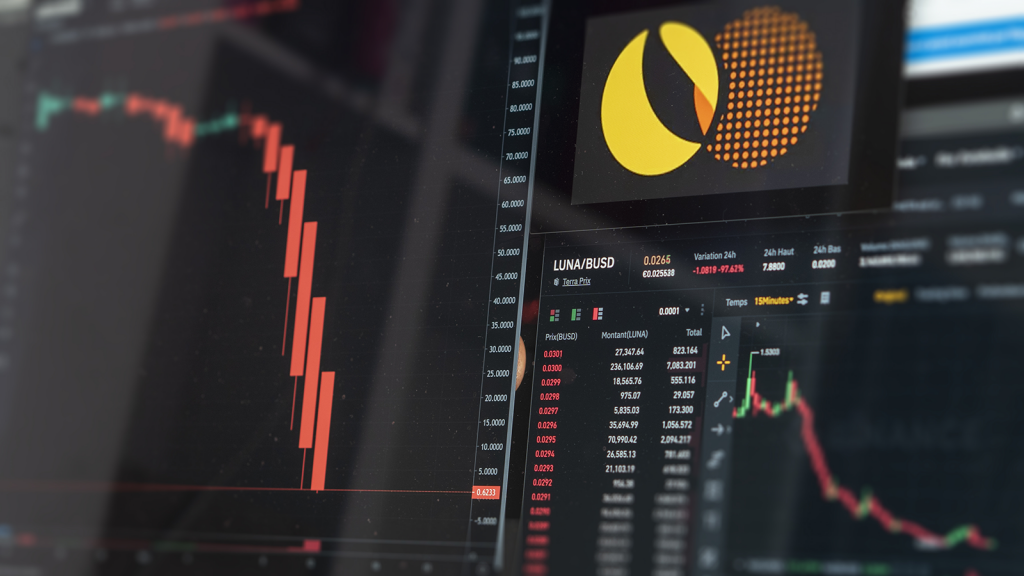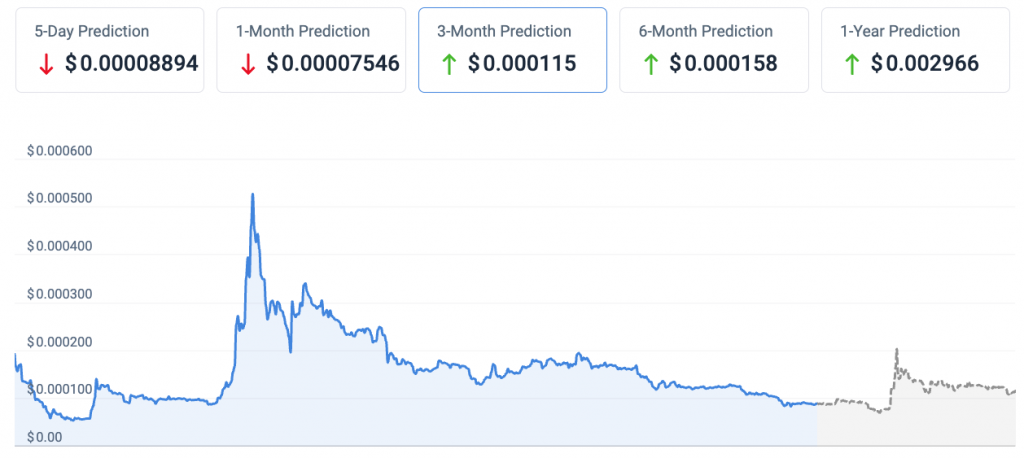Terra Classic (LUNC) is a popular cryptocurrency project that emerged following the dramatic collapse of the Terra (LUNA) cryptocurrency in 2022. In this article, we’ll explore if Luna will recover and become one of the leading crypto projects once again.
Currently, it appears unlikely that Luna will recover fully and match the success it had before its downfall. However, there are potential catalysts that could help Luna recover, such as the ongoing token burning program, community support, and protocol developments.
At its peak, Terra had a market capitalization of $40 billion and was one of the largest cryptocurrencies on the market. Today, its successor Terra Classic has a much more modest market cap of $515 million and is ranked 79th among all cryptocurrencies.
Even if the Terra Classic project does eventually recover, the road will likely be long. To reach its all-time high market cap again, LUNC would have to increase in price by about 77x from its current price.
Before we take a look at Luna Classic’s chances for recovery, let’s quickly recap what actually happened in May of 2022, when the coin’s price abruptly collapsed.
What happened to Terra (LUNA)?

The origins of the Terra blockchain platform date back to 2019, when it was originally launched by Terraform Labs. The company that created Terra was led by software engineer Do Kwon, who was the public face of the project up until its infamous collapse.
How Terra worked
The Terra blockchain was designed to support a range of stablecoins tied to various fiat currencies. The most notable stablecoins issued on the platform were the US dollar-pegged UST and the Korean won-pegged KRT, but Terra also had stablecoins based on other fiat currencies.
Crucially, Terra did not use the standard stablecoin model in which a company holds currency reserves and then issues an equivalent number of stablecoins. Terra instead implemented an algorithmic design, which was meant to automatically keep the value of its stablecoins stable through the fundamental market forces of supply and demand.
The Terra platform integrated an arbitrage mechanism based around its native token, LUNA. Users who held LUNA could burn their tokens to mint stablecoins equal to the value of the burned coins. On the other side of the equation, users could burn their stablecoins to receive LUNA. For example, if a user burned 10 UST, they would receive $10 worth of LUNA.
The rise of Anchor Protocol
For a period of time, this system was successful at keeping the value of Terra’s stablecoins stable. Thanks to its stablecoins, Terra became one of the most popular platforms for decentralized finance (DeFi) applications. Terra’s popularity accelerated immensely in 2021, with its growth primarily being driven by Anchor, a DeFi lending protocol.
The main reason for Anchor’s popularity were the high yields the protocol provided to users that were using it to lend stablecoins. For example, the protocol was offering a 20% APY (annual percentage yield) to users who deposited UST. This was among the highest yields offered on stablecoin deposits in the crypto space.
While the advertised 20% APY on a USD-pegged token was a red flag for some, there were plenty of users who were comfortable in depositing their UST into the Anchor protocol.
The promise of high yields led users to mint more UST, which also helped boost the value of the LUNA token. Before its collapse, LUNA reached a market capitalization of $41 billion and there were $18.7 billion UST tokens in circulation.
The crash
UST was generally successful in keeping its price close to the $1 target peg until May 2022. At this point, the stablecoin’s value began declining below its intended $1 mark.
The situation worsened on May 10th when the UST value plummeted to $0.77, indicating significant issues with its design. Despite the efforts of the Luna Foundation Guard, who utilized their reserves of BTC and other assets to provide additional support for UST’s peg, it proved inadequate in halting the downward spiral of UST.

The algorithmic mechanism responsible for maintaining UST’s value at $1 went into overdrive. Users hurried to exchange their UST for LUNA tokens, leading to a state of hyperinflation for LUNA. By the end of May, UST was being traded at less than $0.03, and a single LUNA token was practically devoid of value.
Terra Classic and Terra 2.0

After this crash, the Terra community split into two camps. A part of the community decided to continue using the same blockchain and keeping its blockchain history and functionality. This project is now known as Terra Classic, and its token is known as LUNC.
The other camp decided to follow a proposal made by Terra’s founder Do Kwon. This project decided to launch a new blockchain called Terra 2.0, which removed the algorithmic stablecoin functionality that ultimately led to the demise of the first iteration of Terra. The token of the Terra 2.0 platform is known as LUNA.
Will Luna recover to $1?
Currently, Terra Classic is more popular and has a higher valuation than Terra 2.0. However, the circulating supply of Terra Classic’s LUNC token is still extremely large due to the hyperinflation that occurred when the UST stablecoin lost its peg in May 2022.
At the time of writing, 1 LUNC token has a price of about $0.000087, and the token’s circulating supply is 5.88 trillion tokens. In order to reach $1, the price of LUNC would need to increase by roughly 11,494x.
At a price of $1, Terra Classic would have a market capitalization of $5.88 trillion. This would be a valuation would be larger than the world’s two biggest companies, Apple and Microsoft, combined. In addition a $5.88 trillion market capitalization would be larger than the all-time high market capitalization of all cryptocurrencies combined (roughly $3 trillion).
With this in mind, it’s extremely unlikely that we will see Luna recover to $1 anytime soon.
This does not mean that’s there’s no hope for the LUNC price to see some positive momentum in the future. The Luna Classic community is extremely active and provides a strong foundation for the coin’s potential success in the future. Still, the Luna Classic blockchain would need to offer something new in order to start gaining serious momentum.
At the moment, Luna Classic is not a particularly innovative project. Perhaps its most unique feature is a LUNC burn tax on all transactions facilitated by the network, which was introduced in an effort to gradually reduce the supply of LUNC.
However, the project’s 0.5% LUNC burn tax on all transactions is a double-edged sword. On the one hand, the tax helps reduce the hyper-inflated supply of the LUNC token. On the other hand, the tax stifles activity on the Terra Classic blockchain, as it provides a direct incentive not to perform transactions.
What’s the Luna price prediction for 2023 and 2024?
Crypto market aggregator CoinCodex provides a Luna price prediction based on a combination of technical indicators and the coin’s price history.
Currently, the Luna price prediction is forecasting a bullish future for Terra Classic. As of May 2023, the prediction is expecting Luna to display 32.6% gains in a period of three months. The 6-month prediction is currently expecting a 96% gain in the next six months, and a whopping 3,820% gain in the next year.

Of course, we need to keep in mind that predicting prices in the highly volatile cryptocurrency market is difficult, and predictions can change quickly based on market conditions.
Luna could recover, but don’t expect it to reach $1
There could still be better days ahead for Luna, especially since the Terra Classic community is very large and the coin has a lot of dedicated holders. However, we most likely won’t see Luna hit $1 because the supply of the coin is simply too large.
The LUNC burn tax implemented by the Terra Classic project will contribute to reducing the token’s supply, but likely not enough to make a huge difference in the LUNC price. The burn tax also has the negative effect of making users less likely to actually make transactions on the Terra Classic blockchain, which could hurt adoption.
If you’re interested in investing in Terra Classic, you’ll likely also want to stake your LUNC tokens to contribute to the network’s security and earn additional LUNC. We provide a LUNC staking guide that will teach you everything you know to stake and earn LUNC.
FAQs
It is unlikely that Luna will recover fully and match the success it had before its downfall. However, there are potential catalysts that could help Luna recover, such as the ongoing token burning program, community support, and protocol developments.

